Electronic rearview mirror research: 2023 will be the first year of mass production as the policy takes effect
Global and China Electronic Rearview Mirror Industry Report, 2023 released by ResearchInChina combs through and summarizes the installation, function application, development trends and products of global and Chinese suppliers.
By installation location, electronic rearview mirrors can be divided into electronic interior rearview mirror (i.e. streaming rearview mirror) and electronic exterior rearview mirror (i.e., camera monitor system, CMS). The "Motor Vehicles - Device for Indirect Vision - Requirement of Performance and Installation" (GB 15084-2022) will come into force on July 1, 2023. The policy stipulates that electronic rearview mirrors can be installed in Category M and N motor vehicles to replace conventional optical exterior rearview mirrors. The industry has grown out of nothing. This article will provide a respective overview of the streaming rearview mirror and CMS markets.
Streaming rearview mirror: the installations surge and the market competition intensifies.
In 2022, the installations of OEM streaming rearview mirrors in passenger cars in China approached 320,000 units, and the installation rate was 1.60%; the number of brands installing OEM streaming mirrors rose to 20, compared with 13 in the first five months of 2022.
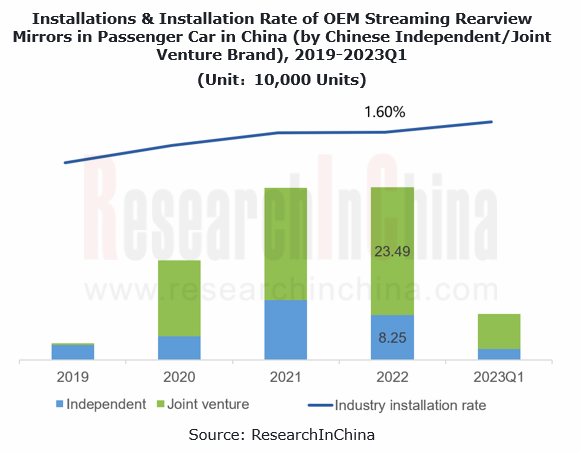
In supplier’s term, Yuanfeng Technology still maintains its position as the bellwether in the industry, but the CR5 declined in 2023Q1, indicating a fiercer market competition.
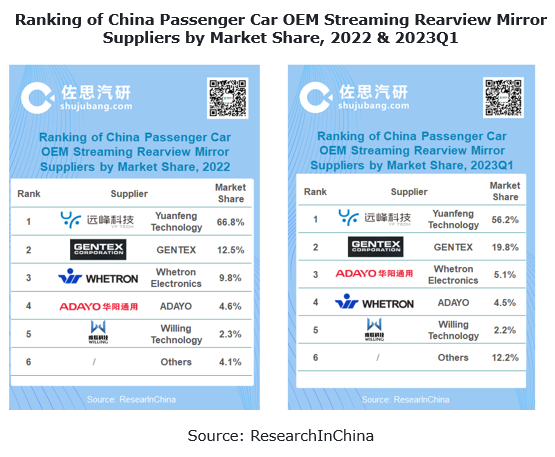
Yuanfeng Technology's fourth-generation streaming rearview mirror products remain very superior in imaging time (25ms, <55ms required by regulations), image delay (<50ms, <200ms required by regulations), system minimum frame rate (≥50fps, ≥30Hz required by regulations) & display brightness (5500cd/m2), high dynamic range (up to 140dB), and self-adaption to high and low light environments. Its products have been installed by Cadillac, Buick, Chevrolet, Hongqi, WEY, Tank, Haval, GAC Trumpchi, GAC Honda, and GAC Toyota among others. Yuanfeng Technology stays far head of its counterparts in installations, having been the sales champion in China for years in a row.
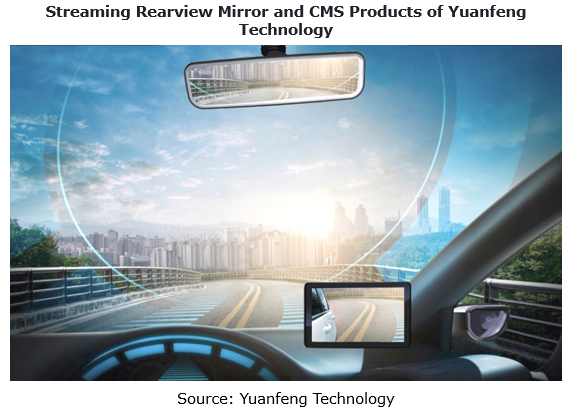
Camera monitor system (CMS): available to quite a few models within the year, with the implementation of the policy.
On December 29, 2022, the Ministry of Industry and Information Technology (MIIT) released the "Motor Vehicles - Device for Indirect Vision - Requirement of Performance and Installation" (GB 15084-2022) and specified that it will go into effect on July 1, 2023. This means that CMS-enabled models will be legal to be mass-produced and travel on roads in China from July 1, 2023. Some models have been confirmed to pack CMS within the year.
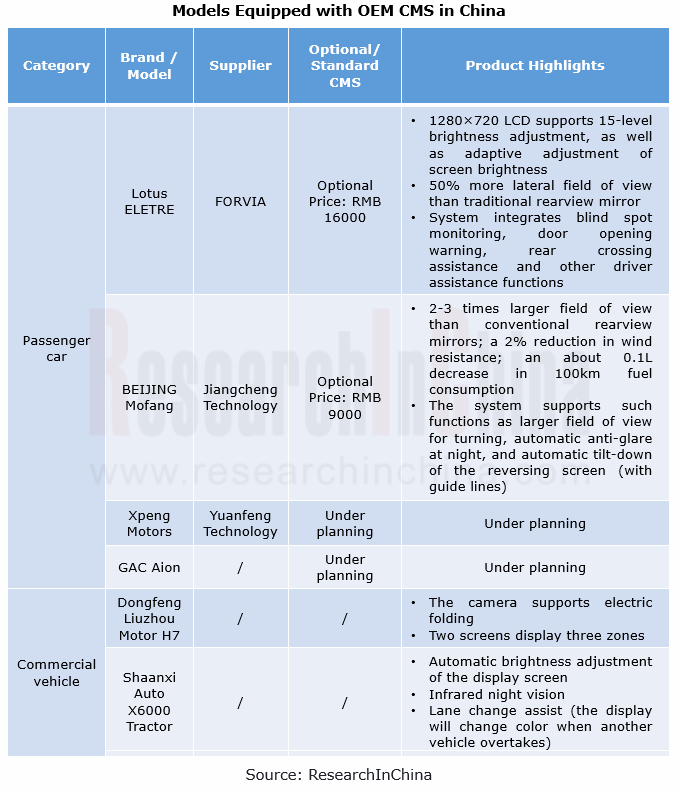
Currently, Lotus Eletre and BAIC Mofang are confirmed to be equipped with CMS within 2023, both of which offer an optional package for consumers. In the case of FORVIA’s solution for Lotus Eletre, the CMS adopts 1280×720 LCD with a refresh rate of 60Hz, and supports 15-level brightness adjustment; the camera using water-proof materials can be heated to melt snow, and works with the active safety systems to provide functions like blind spot detection, door open warning, and rear cross traffic assist.
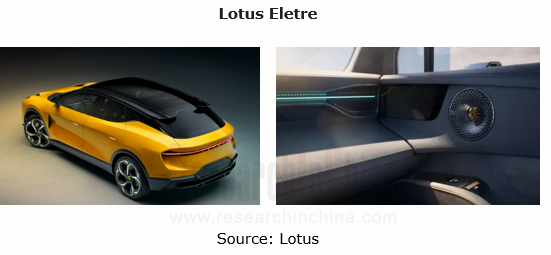
CMS well outperforms conventional rearview mirrors in the following aspects:
 All-day working capability, much stronger than conventional mirrors in special scenarios such as high light/dark environment, rain and snow
All-day working capability, much stronger than conventional mirrors in special scenarios such as high light/dark environment, rain and snow
 Adjustable FOV, effectively reducing blind spots
Adjustable FOV, effectively reducing blind spots
 Wind resistance reduction, and improvements in the BEV range / fuel consumption
Wind resistance reduction, and improvements in the BEV range / fuel consumption
 Video forensics in collision accidents
Video forensics in collision accidents
 Combined with driving assistance systems. CMS and ADAS have a high degree of overlap in functions such as blind spot detection. Currently, CMS products from Yuanfeng Technology and Autocruis can integrate steering assist, lane departure warning, side blind spot obstacle avoidance and other driving assistance functions.
Combined with driving assistance systems. CMS and ADAS have a high degree of overlap in functions such as blind spot detection. Currently, CMS products from Yuanfeng Technology and Autocruis can integrate steering assist, lane departure warning, side blind spot obstacle avoidance and other driving assistance functions.
There is a high possibility that CMS can share camera modules and controller components with other auto parts, producing good cost reduction effects. (According to the regulation in the GB15084-2022, that "in the case where CMS is used to provide a field of view, the relevant field of view shall be permanently visible to the driver when the ignition switch is turned on or the vehicle master control switch is activated", the display multiplexing is an infeasible way to lower the cost).
In terms of camera modules, currently a number of models (e.g., Xpeng G9 and Li L9) with L2+ driving assistance systems pack side cameras. If the CMS can share the camera with ADAS, a portion of the cost can be saved.
In terms of controllers, it is more likely that the CMS controller is integrated into the cockpit domain/driving domain. This solution is more in line with the centralization trend of E/E architectures. According to BAIC, the process will take 2 or 3 years.
Although CMS offers big benefits mentioned above, there are still some bottlenecks to be broken before mass adoption in vehicles, including:
 High cost poses a higher threshold to buy a car before the components are multiplexed. From the existing models with optional CMS on market, it can be seen that the cost of the optional system for customers ranges between RMB7,000 and RMB16,000. Except the purchase cost, the maintenance cost in later stage also increases.
High cost poses a higher threshold to buy a car before the components are multiplexed. From the existing models with optional CMS on market, it can be seen that the cost of the optional system for customers ranges between RMB7,000 and RMB16,000. Except the purchase cost, the maintenance cost in later stage also increases.
 System reliability in long-term use is guaranteed. CMS plays a crucial role in driving. Compared to conventional mirrors, CMS may crash and have a blank screen, causing a threat to safety driving
System reliability in long-term use is guaranteed. CMS plays a crucial role in driving. Compared to conventional mirrors, CMS may crash and have a blank screen, causing a threat to safety driving
 Driver's use habits change. In conventional rearview mirrors, the human eyesight is always in the distance, and what the driver sees is always a distant view; in CMS, the driver needs to take eyes back to the near place instead and refocus when observing the screen. The frequent switching of visual focus for a long time makes it easy to cause visual fatigue and affect driving safety.
Driver's use habits change. In conventional rearview mirrors, the human eyesight is always in the distance, and what the driver sees is always a distant view; in CMS, the driver needs to take eyes back to the near place instead and refocus when observing the screen. The frequent switching of visual focus for a long time makes it easy to cause visual fatigue and affect driving safety.
Automotive 4D Radar Industry Research Report 2025
4D radar research: From "optional" to "essential," 4D radar's share will exceed 50% by 2030.
1. 4D imaging radar has transformed from an "optional" to a "must-have" sensor.
4D radar adds the detecti...
China Automotive Multimodal Interaction Development Research Report, 2025
Research on Automotive Multimodal Interaction: The Interaction Evolution of L1~L4 Cockpits
ResearchInChina has released the "China Automotive Multimodal Interaction Development Research Report, 2025"...
Automotive Vision Industry Report, 2025
Automotive Vision Research: Average Camera Installation per Vehicle Reaches 5.2 Units, and Front-View Tricam Installation Exceeds 1.2 Million Sets.
From January to September 2025, the total installa...
Automotive Infrared Night Vision System Research Report, 2025
Automotive night vision research: The rise of infrared AEB, with automotive infrared night vision experiencing a 384.7% year-on-year increase from January to September.
From January to September 2025...
New Energy Vehicle Cross-Domain (Electric Drive System and Powertrain Domain) Integration Trend Report 2025-2026
Electric Drive and Powertrain Domain Research: New technologies such as three-motor four-wheel drive, drive-brake integration, and corner modules are being rapidly installed in vehicles.
Electric dri...
Analysis on Desay SV and Joyson Electronic's Electrification, Connectivity, Intelligence and Sharing, 2025
Research on Desay SV and Joyson Electronic: Who is the No.1 Intelligent Supplier?
Both Desay SV and Joyson Electronic are leading domestic suppliers in automotive intelligence. "Analysis on Desay SV ...
OEMs and Tier 1 Suppliers' Cost Reduction and Efficiency Enhancement Strategy Analysis Report, 2025
ResearchInChina released the "OEMs and Tier 1 Suppliers' Cost Reduction and Efficiency Enhancement Strategy Analysis Report, 2025", summarizing hundreds of cost reduction strategies to provide referen...
Automotive Fixed Panoramic Sunroof and Smart Roof Research Report, 2025
With the intelligent application of car roofs as the core, this report systematically sorts out a series of new products such as fixed panoramic sunroof/openable sunroof, ceiling screen, roof ambient ...
Automotive-Grade Power Semiconductor and Module (SiC, GaN) Industry Research Report, 2025
SiC/GaN Research: Sales volume of 800V+ architecture-based vehicles will increase more than 10 times, and hybrid carbon (SiC+IGBT) power modules are rapidly being deployed in vehicles.
Sales volume o...
Cockpit Agent Engineering Research Report, 2025
Cockpit Agent Engineering Research: Breakthrough from Digital AI to Physical AI
Cockpit Agent Engineering Research Report, 2025 starts with the status quo of cockpit agents, summarizes the technical ...
Prospective Study on L3 Intelligent Driving Technology of OEMs and Tier 1 Suppliers, 2025
L3 Research: The Window of Opportunity Has Arrived - Eight Trends in L3 Layout of OEMs and Tier 1 Suppliers
Through in-depth research on 15 OEMs (including 8 Chinese and 7 foreign OEMs) and 9 Tier 1 ...
China Commercial Vehicle IoV and Intelligent Cockpit Industry Research Report 2025
Commercial Vehicle IoV and Cockpit Research: The Third Wave of Passenger Car/Commercial Vehicle Technology Integration Arrives, and T-Box Integrates e-Call and 15.6-inch for Vehicles
I. The third wav...
Intelligent Vehicle Electronic and Electrical Architecture (EEA) and Technology Supply Chain Construction Strategy Research Report, 2025
E/E Architecture Research: 24 OEMs Deploy Innovative Products from Platform Architectures to Technical Selling Points
According to statistics from ResearchInChina, 802,000 passenger cars with domain...
Research Report on Intelligent Vehicle Cross-Domain Integration Strategies and Innovative Function Scenarios, 2025
Cross-Domain Integration Strategy Research: Automakers' Competition Extends to Cross-Domain Innovative Function Scenarios such as Cockpit-Driving, Powertrain, and Chassis
Cross-domain integration of ...
China Autonomous Driving Data Closed Loop Research Report, 2025
Data Closed-Loop Research: Synthetic Data Accounts for Over 50%, Full-process Automated Toolchain Gradually Implemented
Key Points:From 2023 to 2025, the proportion of synthetic data increased from 2...
Automotive Glass and Smart Glass Research Report, 2025
Automotive Glass Report: Dimmable Glass Offers Active Mode, Penetration Rate Expected to Reach 10% by 2030
ResearchInChina releases the Automotive Glass and Smart Glass Research Report, 2025. This r...
Passenger Car Brake-by-Wire (BBW) Research Report, 2025
Brake-by-Wire: EHB to Be Installed in 12 Million Vehicles in 2025
1. EHB Have Been Installed in over 10 Million Vehicles, A Figure to Hit 12 Million in 2025.
In 2024, the brake-by-wire, Electro-Hydr...
Autonomous Driving Domain Controller and Central Computing Unit (CCU) Industry Report, 2025
Research on Autonomous Driving Domain Controllers: Monthly Penetration Rate Exceeded 30% for the First Time, and 700T+ Ultrahigh-compute Domain Controller Products Are Rapidly Installed in Vehicles
L...